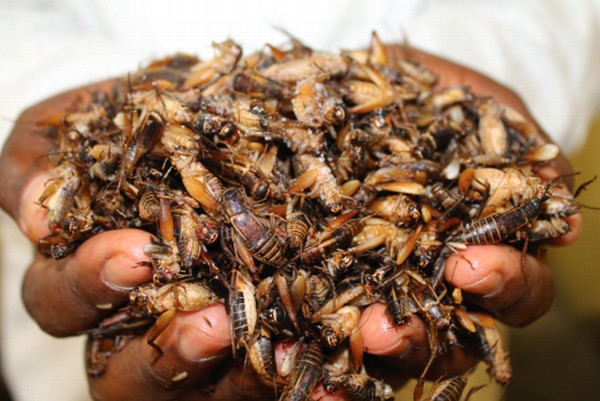
Crickets have high protein content compared to soya beans and beef which are among the common conventional sources of proteins. (pic: Africa.com)
Many smallholder farmers across Kenya and Africa as whole face many challenges including: unreliable rainfall, low crop yields, high energy costs, lack of access to modern farming technology and insufficient access to capital. These challenges can be done away with slowly if farmers try a new venture; cricket farming.
Carolyn Koech, a Jomo Kenyatta University of Agriculture and Technology PhD student in Food Science and Technology has carried out a study on the effectiveness of cricket based food. The study which was conducted on preschool children in Uasin Gishu County aims to ensure food security and boost the nutritional value of food consumed by children in school.
According to Koech, crickets have high protein content compared to soya beans and beef which are among the common conventional sources of proteins.
From January to July this year, Koech provided over 120 nursery pupils with three kinds of porridge meals. One contained Millet and Maize, the other included Millet, Maize and Milk, while the final porridge meal contained Millet, Maize and Cricket.
READ: Insects to supplement proteins in animal feed
Cricket has been incorporated in cakes and biscuits and adding it to porridge seemed like a noble idea to tackle the issue of malnutrition in children,” said Koech.
Koech, the GREEiNSECT PhD scholarship beneficiary, says the high protein content in crickets can be utilized to solve the Protein-Energy-Malnutrition (PEM), a condition that is evident in children suffering from Kwashiorkor and Marasmus.
Dr. John Kinyuru, Koech’s supervisor, acknowledged that the next step is to train the local community on cricket farming for value addition saying that cricket rearing will be vital towards reduction in food insecurity not only in the region but the country as a whole.
READ: Sweet potato vines and roots silage offers livestock more proteins
“I know that entomophagy (eating insects) irks some people but it is a high time we realize that insects are highly nutritious, and also far more environmentally friendly to raise than conventional livestock,” said Dr. Kinyuru.
Ms. Florence Chepkosgei, the Cheptigit Nursery School head, admits that since the beginning of the study, most children have gained weight and their cognitive ability has improved.
The main challenge Koech faced in her study was convincing the preschool children to consume porridge that was mixed with crickets.
According to Melissa Kaplan’s Herp Care Collection there are several things to consider before one can consider rearing crickets:
Materials required
The materials required for a basic setup are as follows:
- 2 Large Plastic storage containers - 'Rubbermaid' or similar (Breeding containers)
- 3 Medium sweater boxes (Rearing containers)
- 6 - 500 ml ( 1 pint) plastic tubs (Nesting and food containers)
- egg 'flats'
- Heat pad (optional) - medical types available at most drug stores work well
- Water dispenser - small chick waterer available at feed shops or specialty pet shops.
- Several jar lids
- Quilt batting or plastic scouring pads
- Aluminum mosquito screening
The cost to establish a basic system is about 3000 Kenyan shillings plus the cost of the initial breeding colony of crickets. To start such a colony at least 200 crickets are required, and the colony should not be used for feeding until well established and your first babies are adult-sized. The crickets can be purchased quite inexpensively from a cricket supplier.
As long as the crickets have food, water and a high temperature they will breed profusely.
















Comments powered by CComment